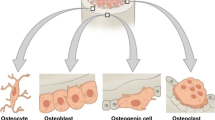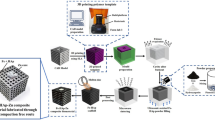Abstract
The brittleness and insufficient strength of biomaterials such as calcium phosphate cement (CPC) limit their applications in physiologically non-load-bearing bone lesions. These limitations stimulated the research for developing degradable polymer-ceramic composite materials that can closely match the modulus of bones. In this study, poly (L-lactic acid)/calcium phosphate cement (PLLA/CPC) composite scaffolds were fabricated via a four-step process, namely, measurement, prototyping, compounding, and dissolving. The design and mechanical properties of the PLLA/CPC composite structures were theoretically and experimentally studied. The PLLA/CPC scaffold improved the mechanical properties of the CPC. The CPC’s compressive strength and strengthening percentage increase with higher PLLA volume. Such composites may have a clinical use for load-bearing bone fixation.
Similar content being viewed by others
References
J. B. Park and J. D. Bronzino, Biomaterials: principles and applications. Florida: CRC Press, (2000) 5.
Z. F. Zhang, Complexity of cellular manufacturing systems based on entropy models, Journal of Mechanical Science and Technology, 24 (2010) 2275–2280.
H. Hockin, K. Xu and G. J. Carl, Self-hardening calcium phosphate composite scaffold for bone tissue engineering, Journal of Orthopaedic Research, 22 (2004) 535–543.
L. F. Charles, M. T. Shaw, J. R. Olson and M. Wei, Fabrication and mechanical properties of PLLA/PCL/HA composites via a biomimetic, dip coating, and hot compression procedure, Journal Material Science: Mater. Med., 24 (2010) 1845–1854.
F. W. Cordewener and J. P. Schmitz, The future of biodegradable osteosyntheses, Tissue Engineering, 6 (2000) 413–424.
P. K. Zysset, X. E. Guo, C. E. Hoffler, KE Moore and SA Goldstein, Elastic modulus and hardness of cortical and trabecular bone lamellae measured by nanoindentation in the human femur, J Biomech, 32 (1999) 177–181.
C. J. Lee, J. Y. Kim, S. K. Lee, D. C. Ko and B. M. Kim, Parametric study on mechanical clinching process for joining aluminum alloy and high-strength steel sheets, Journal of Mechanical Science and Technology, 24 (2010) 123–126.
E. Mittra and Y. Qin, Material properties of sheep trabecular bone determined by nanomechanical testing, Bioengineering Conference (2003) 229–230.
S. Z. Wang and J. Yang, Fast mechanical properties estimation for finite element model of bone tissue, Computer-Based Medical Systems (2008) 147–149.
S. M. Jorgensen, D. R. Eaker, J. Vercnocke and E. L. Ritman, Reproducibility of global and local reconstruction of three-dimensional micro-computered tomography of iliac crest biopsies, Medical Imaging (2008) 569–575.
J. M. Rodriguez, A. A. Pliego and M. V. Trevio, A qualitative stress analysis of a cross section of the trabecular bone tissue of a distal femur by photoelasticity, Bioinformatics and Biomedical Engineering (2009) 422–425.
S. A. Goldstein, The mechanical properties of trabecular bone: dependence on anatomic location and function, Journal of Biomechanical, 20 (1987) 1055–1061.
B. M. Kim, C. J. Lee and J. M. Lee, Estimations of work hardening exponents of engineering metals using residual indentation profiles of nano-indentation, Journal of Mechanical Science and Technology, 24 (2010) 73–76.
X. F. Xiao, R. F. Liu and Q. Y. Huang, Preparation and characterization of nano-hydroxyapatite/polymer composite scaffolds, Journal Material Science: Mater Med., 19 (2008) 3429–3435.
K. Takeshi and T. Katsuhisa, Mechanical properties and morphological changes of poly (lactic acid)/polycarbonate/poly (butylene adipate-co-tereph -thalate) blend through reactive processing, Journal of Applied Polymer Science, 121 (2011) 2908–2918.
X. Zhuo, N. Y. Yong and R. J. Zhang, Fabrication of porous poly (L-lactic acid) scaffolds for bone tissue engineering via precise extrusion, Scripta Materialia, 45 (2001) 773–779.
A. J. McManus, R. H. Doremus, R. W. Siegel and R. Bizios, Evaluation of cytocompatibility and bending modulus of nanoceramic/polymer composites, Journal of Biomedical Material Research, 72A (2005) 98–106.
T. Tian, D. Jiang, J. Zhang and Q. Lin, Fabrication of bioactive composite by developing PLLA onto the framework of sintered HA scaffold, Materials Science and Engineering C, 28 (2008) 51–56.
G. Yuan, Design principle of armored concrete structure, Shanghai: Tongji University Press (1990).
Z. Z. Chen, D. C. Li and B. H. Lu, Study on the new fabrication method of bioactive bone, Chinese Journal of Mechanical Engineering, 16 (2003) 145–148.
S. L. Xu, D. C. Li and B. H. Lu, Fabrication of a calcium phosphate scaffold with a three-dimensional channel network and its application to perfusion culture of stem cells, Rapid Prototyping Journal, 4 (2007) 32–41.
L. F. Charles, M. T. Shaw, J. R. Olson and M. Wei, Fabrication and mechanical properties of PLLA/PCL/HA composites via a biomimetic, dip coating, and hot compression procedure, Journal of Material Science and Medical, 21 (2010) 1845–1854.
A. M. Zihlif, Z. Elimat and G. Ragosta, Thermal and mechanical characterization of polymer composites filled with dispersed zeolite and oil shale, Journal of Composite Materials, 6 (2011) 1209–1216.
Author information
Authors and Affiliations
Corresponding author
Additional information
Recommended by Associate Editor Heung Soo Kim
Shanglong Xu is an associate professor and PhD supervisor in University of Electronic Science and Technology of China. He received his Ph.D from Xi’an Jiaotong University, China, in 2007. His research interests include advanced fabrication and electronic cooling technology.
Rights and permissions
About this article
Cite this article
Xu, S., Guo, W., Lu, J. et al. Fabrication and mechanical properties of PLLA and CPC composite scaffolds. J Mech Sci Technol 26, 2857–2862 (2012). https://doi.org/10.1007/s12206-012-0732-9
Received:
Revised:
Accepted:
Published:
Issue Date:
DOI: https://doi.org/10.1007/s12206-012-0732-9




